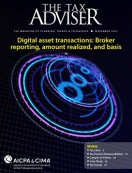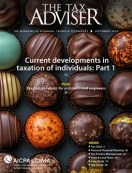- tax clinic
- partners & partnerships
Partnerships in distress: Raising capital and debt exchanges
Related
PTEs need more notice of changes, more time to respond, AICPA says
Tax Court applies limited partner functional test for self-employment income
Final partnership adjustment not issued timely
Editor: Rochelle Hodes, J.D., LL.M.
A noticeable recent reduction in merger-and-acquisition activity corresponds to another trend — recapitalization and debt workout transactions intended to salvage floundering partnerships. This discussion provides an overview of tax planning issues for partnerships and their partners when raising capital and exchanging debt for equity.
Background
With the explosion of private-equity investment in 2020 and 2021, many businesses receiving these investments (referred to here as “operating companies”) experienced significant growth and were monetized in 2022 and 2023. However, some operating companies experienced the opposite, losing revenue and leaving private-equity owners with a dilemma of how to fund the needed capital to keep the business afloat. Most, if not all, private-equity funds are structured at the investor level as either state-law partnerships or other state-law entities that elect to be treated as partnerships for federal income tax purposes (“partnership” is used here to describe any entity that elects to be treated as such for federal income tax purposes). The operating companies also are often structured as partnerships. When faced with recapitalizing, either the fund partnership or the operating company partnership (or both) must navigate complicated partnership rules, including rules on taxable income allocation under Sec. 704.
As a general matter, Sec. 704 sets forth two basic rules for valid allocations for income tax purposes. The first is that allocations must meet the substantial-economic-effect standard (Regs. Sec. 1.704-1(b)(2)). The second is that an allocation must be made in accordance with the partner’s interest in the partnership (Regs. Sec. 1.704-1(b) (3) ). Under both rules, allocating a dollar of income or gain to a partner must entitle that partner to an extra dollar of cash on liquidation. Moreover, both rules are based on the partnership’s following the capital-account-maintenance rules in Regs. Sec. 1.704-1(b)(2)(iv), with which compliance is significant, particularly when evaluating the tax consequences of additional equity infusions where the value of the underlying partnership has changed.
When considering recapitalizations and debt workouts, the first question is whether the partnership will be best served by using equity, debt, or a combination of the two to address liquidity needs. This decision is driven primarily by existing restrictions (for example, those in creditor and operating agreements); what the partnership can economically sustain; and the funding parties’ economic needs. However, the tax ramifications of each option are an important consideration.
Change in equity structure
If new equity will be issued to provide funding, the primary focus is how the transaction affects Sec. 704(b)(1) partner capital accounts both before and after the raise. If the goal is to reflect the current economics, the partnership will typically perform a revaluation of each partner’s interest in the partnership under Regs. Sec. 1.704-1(b)(2)(iv)(f), usually by adjusting each partner’s asset basis and capital accounts to reflect the current value and the economics of the additional capital. Such an adjustment affects only the partners’ Sec. 704(b) capital and as such creates a disparity between the Sec. 704(b) balance sheet and the tax balance sheet. While this dynamic is very common when forming a partnership, the complexities multiply when a revaluation occurs after the partnership is formed and is operating.
One contributor to this complexity is Sec. 704(c). When a partnership is formed and a partner contributes an asset with a value different from its tax basis, practitioners refer to this as a “forward Sec. 704(c) layer.” While outside the scope of this discussion, the regulations under Sec. 704(c) dictate that a partnership must allocate items of income, gain, loss, or deduction with respect to contributed property among its partners so as to allocate the benefits and burdens of built-in gain or loss to the contributing partner. The Sec. 704(c) regulations allow taxpayers significant flexibility by providing three methods a partnership can use to allocate these items (traditional, traditional with curative allocations, and remedial; Regs. Secs. 1. 704-3(b), (c), and (d)). The choice of method is typically negotiated between the partner contributing the asset and the other partners because it directly affects how much taxable income will be allocated to each partner.
For partnerships already operating, raising additional equity can have the effect of revaluing the assets and capital accounts. In this context, practitioners often are faced with capturing a reverse Sec. 704(c) layer for existing partners. Revaluing the partnership’s assets and capital accounts will create a separate built-in gain or built-in loss layer under Sec. 704(c) (commonly referred to as a “reverse 704(c) layer”), based on the partner’s ownership at the time. As a further consideration, Regs. Sec. 1. 704-3(a)(6) indicates that the partnership may choose to use a different Sec. 704(c) methodology for this new Sec. 704(c) layer on assets contributed by partners or previously revalued, resulting in significant flexibility.
Another complexity is that revaluations often have surprising results when using a target capital allocation approach to allocate partnership income, which lately seems to be many partnerships’ choice. Under a target capital approach, the partnership allocates Sec. 704(b) income to get the partners’ capital accounts as close as possible to the cash each partner would receive if the partnership liquidated. For this purpose, the targeted value used is the value the partners agreed upon prior to the equity infusion. Therefore, when a partnership revalues its assets and capital accounts after an equity raise, the effect can be surprising because while the revaluation will capture the reverse Sec. 704(c) layer, targeted capital can cause unexpected results as Sec. 704(b) controls who is allocated Sec. 704(b) income. Correspondingly, this affects how to allocate taxable income under Sec. 704(c).
A revaluation in the case of a distressed partnership adds complexity. For partnerships not in distress, a revaluation could result in a Sec. 704(b) capital account adjustment (after reaching a distribution threshold) for partner profits interests. For distressed partnerships, it is possible that certain classes of units will be revalued to little or no value as a result of changes to liquidation preference, which will likely result in a Sec. 704(c) built-in loss. Liquidation preferences are typically changed to reflect that new equity will have priority in the distribution waterfall and, in the case of a distressed partnership, partners whose units are subordinate may not receive any proceeds on a deemed liquidation at the current valuation.
Despite these complexities, additional equity is often the preferred means of raising capital for institutional partners in distressed partnerships. To incentivize other partners to participate, they will often insist on a premium return on the additional funds. The premium can be created by issuing a new class of equity with a priority in the distribution waterfall that typically has a high-yield preferred return. For extremely distressed partnerships requiring a substantial capital infusion, the premium could be in the form of a requirement that new equity receives one to three times the investment before existing equity participates in distributions. This type of equity recapitalization could result in a capital shift of previous capital contributions by an existing partner to the capital account of another partner. While there is little direct guidance on such a shift in the Internal Revenue Code or regulations, analogous guidance in Regs. Secs. 1. 721-1(b)(1) and 1.761-3 indicates that immediate taxation could result. For instance, Regs. Sec. 1.721-1(b)(1) provides that a partner that gives up their right to be repaid for their capital contribution in favor of another partner is treated as if they received compensation for services. In addition, Regs. Sec. 1.761-3 requires shifts in partner capital when certain partnership options are exercised.
Taxpayers should also consider whether an equity raise could result in a change to allocation of debt for Sec. 752 purposes. Regs. Sec. 1.752-3 provides a great amount of flexibility in allocating nonrecourse debt, but if the equity is used to pay down existing indebtedness, a deemed cash distribution under Regs. Sec. 1.752-1(c) would result. This could have negative tax consequences for partners, including at-risk loss recapture under Sec. 465(e) or gain on distributions in excess of basis under Sec. 731(a)(1).
Exchanging debt for equity
While exchanging debt for equity in an existing partnership may result in a variety of tax consequences, one important issue is the potential for cancellationof- debt income (CODI). Under Secs. 108(e)(8) and 721, when a partnership exchanges its debt for equity, the partnership is treated as having satisfied the indebtedness with an amount of money equal to the fair market value (FMV) of the equity interest. Generally, the resulting CODI is included in the distributive shares of taxpayers who were partners in the partnership immediately prior to the exchange. Allocation of CODI is subject to the principles of Sec. 704(b) and minimum gain chargeback requirements of Regs. Sec. 1.704-2. In addition, special allocation rules under the partnership’s operating agreement might apply (see also Rev. Ruls. 92-97 and 93-7).
Because determining the FMV of the equity interest exchanged for debt can be difficult, Regs. Sec. 1.108-8 provides a safe harbor based on the liquidation value of the equity interest. However, the safe harbor is subject to a litany of qualifiers, including that the exchange must have terms similar to those that would be agreed upon by unrelated parties (Regs. Secs. 1.108-8(b)(2)(i)). Taxpayers should work with counsel to ensure these qualifiers are properly considered. The investment to acquire the equity in a debt-for-equity exchange is treated as a tax-free contribution under Regs. Sec. 1. 721-1(d) to the extent of the face value of the debt.
Although it may seem prudent to avoid CODI if possible, it may be in the partner’s best interest to recognize CODI in situations where they can avail themselves of an exclusion from CODI recognition under either the Sec. 108(c) real estate exclusion or the rules for insolvency under Sec. 108(a)(1)(B). This is because under Sec. 108(b)(5), Sec. 108(d)(6), Sec. 1017(b)(3)(C), and Regs. Sec. 1.1017-1, a partner may also elect that any attribute reduction be first applied to the partner’s interest in the partnership’s depreciable property. However, the partnership must consent to this election.
It is also important to consider the impact on the partners once the dust settles. For instance, equity received in exchange for debt might include a liquidation preference or a preferred yield, which could result in complications for tax basis purposes when allocable debt is reduced or shifted under Sec. 752 as outlined above.
Many businesses are structured as a holding partnership that wholly owns the operating company as a single-member limited liability company that is treated as a disregarded entity (DRE) under Regs. Sec. 301.7701-3(b)(1). If a creditor of a distressed partnership using this structure exchanges its debt for equity in the DRE, the DRE will be treated as a partnership under the default rules of Regs. Sec. 301.7701-2(c).
The blossoming of a new partnership in this scenario should be governed by Rev. Rul. 99-5, which addresses the tax consequences when a single-member entity that is disregarded becomes an entity with more than one owner. The legislative history of Sec. 108(e)(8) and the proposed and final regulations under that section are silent as to the tax treatment of a swap of debt for equity in a DRE. However, the preambles to the final regulations on noncompensatory partnership options and the proposed regulations on the transfer of equity for services provide that Sec. 721 does not apply to the transfer of equity in a DRE that becomes a partnership as a result of the transfer (see T.D. 9612, 78 Fed. Reg. 7997, and REG-105346-03, 70 Fed. Reg. 29675, 29679). However, a debt exchange is not contemplated by Rev. Rul. 99-5 and does not fit neatly into its framework. At first glance, both partners could be viewed as having contributed property to the newly formed partnership, similar to Situation 2 of the ruling. If Situation 2 applies, the debtor partnership could be deemed to contribute property subject to the debt. On the other hand, the creditor could be deemed to first contribute the debt to the debtor partnership, which could mean that Sec. 108(e)(8) applies.
But the transaction could also be viewed as if the creditor had contributed an asset when the debt is subsequently extinguished. In addition, the debtor partnership could be viewed as receiving debt relief as a form of consideration similar to Situation 1 of the ruling, which would result in the transaction being taxable to the debtor partnership. If Situation 1 applies, the debt must be characterized as either recourse or nonrecourse under Sec. 1001 to determine the tax consequences of the taxable exchange. This determination can be particularly troublesome in the context of debt held by a DRE because IRS guidance has held in some instances that the debt is per se nonrecourse and in other instances that the debt is subject to a facts-and-circumstances analysis (cf. Chief Counsel Advice Memorandum 201525010 and Field Attorney Advice 20150301F; see also Stringfield, “Tax Court Rules Cancellation of Debt Is Part of Gain Realization,” 55-3 The Tax Adviser 18 (March 2024)).
Exchanging debt for equity in these structures raises more questions than answers. If a debt/equity exchange is necessary for business reasons, careful attention should be paid to the form of the transaction, the stated intent of the parties, and the liquidation value of the interest received by the creditor. In the absence of guidance, taxpayers may have flexibility but must be cautious and consider whether the IRS could determine that the general principles of Secs. 108(e)(8) and 721 are being circumvented.
There also can be surprising tax consequences when an existing creditor enters the partnership with equity. In these situations, a portion of existing debt may be recharacterized as recourse, resulting in changes to both the liability allocation and partner/partnership minimum gain tracking for Sec. 704(b) nonrecourse deductions. Under Regs. Sec. 1.752-2(b) a partner bears the economic risk of loss for a partnership liability to the extent that the partner or a related person makes a nonrecourse loan to the partnership and the economic risk of loss for the liability is not borne by another partner. As such, by a partnership’s admitting a lender, the liability could be recharacterized as recourse, which could have significant consequences to the existing partners under Sec. 465(e) or 731(a)(1).
Final thoughts
Recapitalizing distressed partnerships raises complex tax issues. Taxpayers should carefully model the outcomes from various options before engaging in one of these transactions.
Another consideration is whether the parties’ characterization of the funding instrument will be respected. Funding instruments have grown in complexity and variety. Taxpayers should consider whether an instrument’s purported form will be respected for tax purposes, especially in the case of convertible debt and noncompensatory options, either of which has the potential to be treated as equity upon issuance in certain circumstances.
As partnerships navigate through liquidity concerns, they will need to understand the areas of risk and uncertainty as well as the tax consequences of the transaction, both before and after it closes. Taxpayers should work closely with tax advisers and legal counsel throughout the process to prevent unintended consequences.
Editor notes
Rochelle Hodes, J.D., LL.M., is principal with Washington National Tax, Crowe LLP, in Washington, D.C.
For additional information about these items, contact Hodes at Rochelle.Hodes@crowe.com.
Contributors are members of or associated with Crowe LLP.














